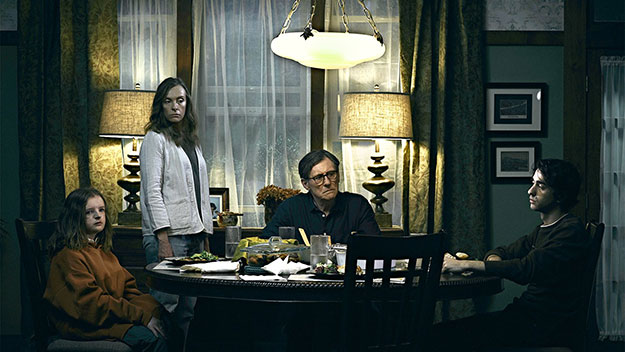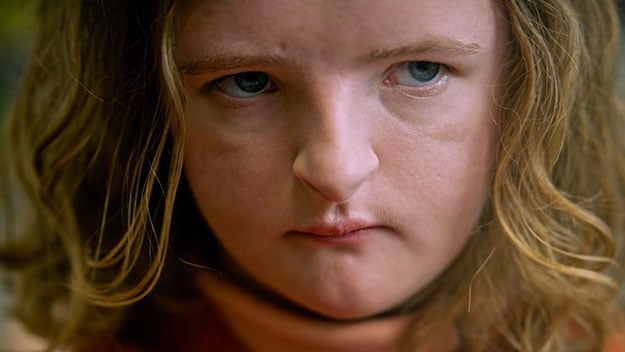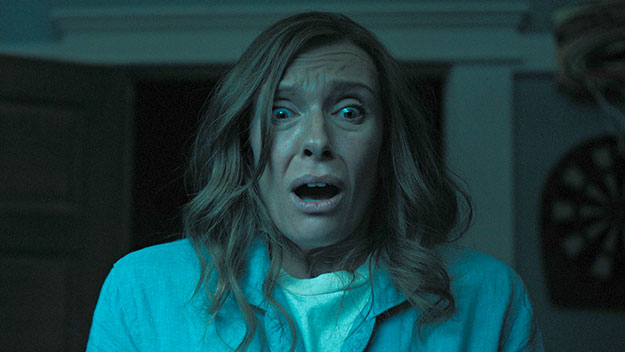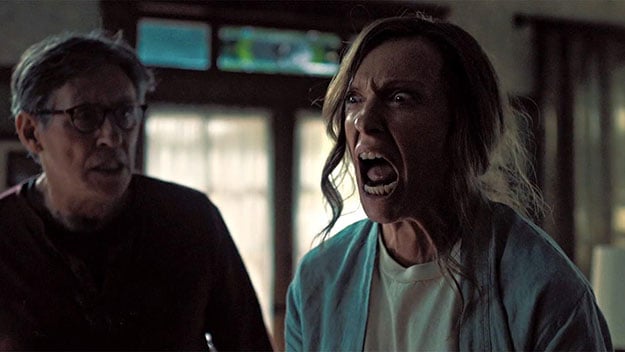Interview: Ari Aster
Ari Aster does not consider himself a horror director. He’ll have to keep explaining why, though, as his debut feature Hereditary is one of the most effective examples of the genre in recent years. With this film, finally opening in theaters after creating quite a buzz among its passionate—and emotionally drained—fans at Sundance and South by Southwest, Aster has made a film filled with spirits, possession, and ghoulish violence but which is perhaps more invested in the domestic dramas and inner lives of its central characters, making for a sympathetic and therefore highly discomfiting experience. A Grand Guignol tale filmed with unnerving restraint, Hereditary is about family—the terrors of the past and the horrors of living in the present—and the impossibility of escaping fate and legacy. I spoke with Aster in New York about the state of contemporary horror, his provocative beginnings at AFI, and what scares him, both in the movies and in life.
Read Michael Koresky’s essay on Hereditary in the May-June issue of Film Comment.

Hereditary incorporates typical horror elements, but overall it’s a tough experience. Were you surprised by the overall positive response to your film at Sundance and South by Southwest?
I’m still kind of shocked by it. I was making an alienating film whose primary aim was to upset the audience in a very deep way. So I am surprised and gratified. It’s a pretty punishing experience if it’s working. People are very quiet for long stretches of the film, and you don’t know if it’s because the film actually hit or completely missed its target. The first screening was for me too quiet for comfort. The next one was kind of ecstatic. The third had a very vocal audience, and it was quite palpable. I heard the movie working, and I never had that experience before.
It’s an interesting moment for horror, with horror films being bought up by Netflix and Shudder and other streaming sites. So there isn’t necessarily a communal theatrical experience for many of them. What is your opinion on the horror genre right now and where it’s going?
I think one reason you have so many films ending up on VOD or streaming platforms right away is because horror films are the easiest to get made—a built-in audience exists for them. And so people end up making them however they can, and there’s a slapdash quality to a lot of them. Aesthetics are put second. I’m excited by the films that are aesthetically daring and interesting and bolder and ambitious. I used to be voracious for horror. I had to see everything when I was 12 or 13. It’s just so rare that I walk out of a contemporary horror film and feel invigorated.
When people ask if I consider myself a horror director, I’ll be quick to respond with a very clear no, absolutely not. Because there are so few horror films that for me live up to what the genre can do. That epidemic has given the genre a bad name. It’s one of those genres that, if its virtues are being effectively exploited, can be just the most amazing experience in a theater. When they work, I get very excited. The South Koreans are so good at horror in general, and they’re also so good at mixing genres, but in a coherent way. There’s this film called The Wailing. For me that was an experience. It’s a police procedural that’s also a goofy black comedy about a police detective that turns into a serial killer film that then becomes a satanic possession movie that becomes almost Pinter-esque in its brand of existentialism.
The Wailing went all the way in providing a terrible kind of resolution. Your film similarly implies that resolution might be the most horrific thing of all. The ending reminded me of The Last Temptation of Christ, and how just the phrase “It is accomplished” can be terrifying.
I had the same response to Dreyer’s Ordet. That really bothers me. I don’t have faith, but that film, I feel it, and it’s upsetting because then I’m dropped back into my life, where I don’t really have a god. So I felt something there. But am I doomed? A big touchstone for me was Don’t Look Now. Nic Roeg is interesting because you’d expect a director who started out as a cinematographer to become like Tarkovsky, precious about his images, but he became like Eisenstein. He was all about montage. So aesthetically I find his films so exciting, but I don’t draw from them at all. Don’t Look Now for me serves as a very serious meditation on grief, and it’s also horrifying. But it’s horrifying because you’re so invested in these people and what they go through. So I see Hereditary as something of a spiritual sibling to Don’t Look Now. Part of what makes that film disturbing is the music by Pino Donaggio, who also did the music for De Palma’s Carrie, which fucking horrified me.

And De Palma’s Dressed to Kill throws you off instantly because the music is so insistently pretty.
Yeah. It’s so sentimental. There’s an icky quality to the sentimentality that gets to me. Bordering on kitsch. Kitsch has always scared me. Artifice has always bothered me. The filmmaker who ruined my life as a kid was Peter Greenaway. I can’t say that I like him as a filmmaker, I actually think he’s maybe our most authentic misanthrope. You feel that he hates people—you really feel it in a way that bleeds into the aesthetics of his films. It’s that sickly light he got from Sacha Vierny, and he’s working with these Brechtian distancing effects where it’s all so stagy and cold and the environments are so controlled. You have the costumes in The Cook, The Thief, His Wife & Her Lover, and they change to match the rooms as they go from one to the next. I saw The Cook, The Thief when I was very young, because my dad said that it scared him, and nothing scared him. So my dad said I couldn’t see it. I was like 12 or 13, and we’d go every Friday to rent movies. And I remember pulling the videotape out of the box and putting it into Troop Beverly Hills or something. And I really regretted it. Whenever I would walk around in the dark at night, I would project those images onto the walls, of the lover’s body that looks like a roasted turkey. But a big part of it is the beauty of the film: there’s a real ugliness to the content, to the cold eye he’s casting on all this stuff. You have Michael Gambon as the thief and he’s a repugnant person, but you don’t feel that Peter Greenaway has warmer feelings for Helen Mirren or the lover.
Because there’s no moralizing.
There’s no moralizing, and if anything you feel he has more affection for the thief simply because he’s more alive than they are.
So is your charred body in Hereditary a reference to Greenaway?
I’m sure it was. We were going for this kind of dollhouse aesthetic, and whenever I said that people would mention Wes Anderson, and I’d say, “No, no, no… Peter Greenaway.” That’s something that stayed with me, how upsetting I found those sets. I find that some of the films I am most enamored of really play with the Brechtian distancing. Pennies from Heaven really bothered me when I first saw it. And that’s disturbing in obvious ways, but it’s the stagy blocking and the artifice. Obviously that film is playing with tonal incongruities in literal ways. I don’t think I’ve ever been more affected by anything in a theater than Dogville. That felt like such an immediate film. You shouldn’t fall into that movie. Everything is there to alienate you and push you out, but you get so drawn in. And the catharsis of the ending really implicates you, much more than Funny Games. I felt very implicated by the end of Dogville—like, whoa, I was watching a three-hour justification for the eventual mass murder of an entire village. And I’m all for it.
That kind of artifice really disturbed me as a kid. Douglas Sirk is somebody else. I love Sirk, but Imitation of Life scarred me. The funeral outside with everyone in those colorful outfits. There’s something so perverse about what he’s doing with color. One of my shorts, The Strange Thing About the Johnsons [2011], was my Sirkian film. That was a weird mutt of a movie, where it started as one thing then became another and then another. I was at AFI, which is a kind of industry school. They’re very Hollywood-oriented and they want to train you to become a Hollywood filmmaker, and the films they show the incoming fellows are very politically correct, you know, Oscar movies. And I just thought, what’s the worst thing I can make at AFI?
So the impetus for the film was trying to figure out the thing that will upset people the most?
To ask, what can’t I do? And why can’t I do it? Oh, a son raping his dad, we should make that a movie. And then to figure out what makes that palatable and how to make that work. So it was an exercise, really, and it was a stunt, and a punkish one. At first, it was like, okay, I’ll make something campy, what was in my head at first was very John Waters, something like a Lifetime movie about an issue that does not exist—this domestic abuse hysterical freak-out. And then the challenge became how do I draw the tongue from the cheek enough to confuse people about what this is. Is this a comedy or is this a melodrama that is weirdly presenting itself as though it thinks that this is a real issue?

Obviously there are connections between the films. There are taboos in them, and they’re about family units that don’t function. Also, viewers of both films are put in a position of trying to figure out the characters and the gaps between them. In writing Hereditary, how much did you feel you were giving people in terms of narrative information? Was there a lot of subtraction?
No, in fact I was adding things. I never took anything away. The script was always a long one. It was like 156 scenes. The first cut was three hours, and then everything we cut out was family drama stuff. All the horror stuff was in there, but the original film took even more time to get there. I did have this one aim to make a horror film that ends up becoming about a conspiracy that had as little exposition as possible. There are a couple scenes where I found I had to cheat a little on that and provide some exposition. But basically I littered the film with hints and just enough pieces of the puzzle to allow the audience to put it all together. And obviously at the end there’s catharsis, and you need to have enough there so it’s all clicking into place.
The film doesn’t answer what’s really happened in the past, and the future is so unsure, so the viewer is constantly in the present moment, aligned with the people this is all happening to. And since they have no idea, it’s like we’re identifying with confusion the whole time.
This is a bit of a spoiler, but the big pitch was I’m making a film about a possession ritual from the perspective of the sacrificial lambs. That’s what the film is meant to be doing. So we only learn what they piece together. And then there’s a little extra at the very end being delivered to this empty vessel that we were invested in before he was emptied out. I don’t know what it says about me, but those are the things that really upset me, like what Greenaway does. Like what Carrie does. I was really bothered by Carrie as a kid. Obviously the performances by Sissy Spacek and Piper Laurie are so brilliant, but there’s also De Palma’s campy side. I don’t know. It’s so cruel to her. It butters you up. You’ve seen the ugly duckling story so many times, so you think, okay, Carrie’s going to be prom queen. It’s a film that really turns on you and really betrays you. Because you do care about Carrie. She doesn’t deserve what’s happening to her.
But the crazy thing is neither do most of the people who get killed at the prom. Exactly. It’s filled with betrayals. And that is something I wanted to do here. To make a film that betrays you on every level, where you become invested in all these people, and what happens to them is not fair. You have to contend with it. My biggest problem with recent horror films is that I really feel like there’s this agenda—I don’t know if it’s a studio agenda—to let you off the hook. And if everyone gets fucked at the end, they make sure you’re not invested in anybody. And the films that always got to me were operating on more of an existential level, where it’s like, okay, we’re going to pose the problems of life, things tapping into your most primal fears—death, does anybody really know anybody?—and not resolving anything, just rubbing your face in the inevitability of all that stuff. That stuff’s not pleasant and we think we go to horror movies to avoid them. We want to go to an experience, we want to be riveted, taken on a ride, and we want to be scared. And I think with Hereditary, and other films I’m referencing, they turn on you, they ask, so do you really want to be scared? And the only way I know how to do that is to go into my own fears and what bothers me.
What are your fears?
I’m afraid of dying alone. I’m afraid of being responsible for something horrible happening to someone I love and then not being forgiven. I’m afraid of somebody in my family turning on me. That’s something I’m not even aware of consciously, but my nightmares as a kid were always about someone who matters most to me changing. Even if you go back to Freud’s essay on the uncanny—and I’m probably misrepresenting what he said—but he says that horror is when the home becomes un-homelike, unheimlich. And that is something I was thinking about a lot in this film. I wanted to make a home that became something malign and unrecognizable by the end. And that’s where the miniatures come in as well. It’s a replica of the real thing. It is the thing, but it’s not the thing. That is your mother, but it’s not your mother.

What was the process of creating all those miniatures?
Logistically, it was a nightmare. I don’t recommend this way of working necessarily, but I’m someone who comes with a shot list before production so I know how I want to shoot everything in advance. It puts everyone else in the corner, which is not necessarily very nice.
That’s very Terence Davies of you.
I love Terence Davies. One of the shots from Strange Thing About the Johnsons is a Davies shot. The push in on the family at the wedding is right out of Distant Voices, Still Lives. Anyway, so we were looking for a house that would accommodate our shot list and we didn’t find one. We found one that was close enough, but we would have had to do a lot of altering of the house to accommodate the shot list, so we found it would be cheaper to build all of the interiors. So everything inside that house was built from scratch on a stage.
Movies built on sets are often much more memorable and uncanny, like The Shining and Eyes Wide Shut.
Exactly. So the upstairs floor and downstairs floor were built, and the attic, and the treehouse, which we built two versions of. We found we needed to design everything in advance of shooting because we needed to know the dimensions of each room, and the dressing for each room, what’s on the walls, what’s the furniture, what’s on the beds, what are the drapes, because we needed to replicate all of that small, and that stuff’s harder to replicate than the rooms themselves. So it was quite a task. Miniatures were coming in on the day we had to shoot them. And we pushed all of that to the end.
So Toni Collette had already gone through hell and got to relax with some toys, then. Speaking of Toni Collette, can you talk about directing such an outsized, emotional performance amidst such strict compositions?
It’s funny. I tried to hide a lot of what we were doing with the camera. The camera’s actually quite agile in the film. There’s almost no coverage in the film. You have the camera revolving around these people and you have these cut points, like the séance scene. With the actors it’s easier—Toni Collette and Alex Wolff, who both went through hell on this movie—to not have to get coverage and do it several times. It feels tragic if you have a great performance and the camera doesn’t hit its mark. Because in a film like this you have a standard you have to maintain for the performances and the camera. So in some ways it’s beneficial to the actor because they can play through the whole scene without any cuts. In other ways it’s hampering, because my blocking is very specific. I would love to find a way to work in a more fluid manner so I can work more with the actor in finding the blocking. At times the set was volatile. I’m asking a lot of actors. To get them to jump off the deep end.
Michael Koresky is the Director of Editorial and Creative Strategy at Film Society of Lincoln Center; the co-founder and co-editor of Reverse Shot; a frequent contributor to the Criterion Collection; and the author of the book Terence Davies, published by University of Illinois Press.







